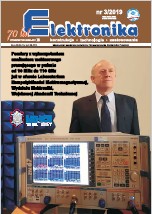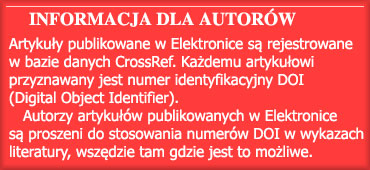 Spis tresci zeszytu Elektronika nr 3/2019
ZASTOSOWANIE INTERFEJSU BLUETOOTH LOW ENERGY DO TRANSMISJI
DANYCH WTRYBIE PORTU SZEREGOWEGO
Spis tresci zeszytu Elektronika nr 3/2019
ZASTOSOWANIE INTERFEJSU BLUETOOTH LOW ENERGY DO TRANSMISJI
DANYCH WTRYBIE PORTU SZEREGOWEGO
(Using the Bluetooth Low Energy interface for data transmission
in serial port mode)
T. SONDEJ, P. DĄBROWSKI ..............4
STRESZCZENIE
W artykule przedstawiono sposób konfiguracji i wyniki badań
interfejsu Bluetooth Low Energy (BLE) do transparentnej transmisji
danych w trybie portu szeregowego (UART). Określono
najważniejsze czynniki wpływające na szybkość transmisji
danych. Opisano przykładowe łącze bezprzewodowe, zawierające
dwa moduły BLE i pracujące w trybie transparentnego
interfejsu UART. Przeprowadzono badania eksperymentalne
w celu pomiaru rzeczywistej przepływności dla przesyłanych
danych. Dla najkorzystniejszych ustawień, uzyskano dużą
przepływność o wartości około 500 kb/s.
SŁOWA KLUCZOWE:Bluetooth Low Energy, wirtualny port szeregowy,
bezprzewodowa transmisja danych
ABSTRACT
The article presents the configuration and test results of the
Bluetooth Low Energy (BLE) interface for transparent data
transmission in the serial port (UART) mode. The most important
factors affecting the data transmission rate are determined.
An example of a wireless link consisting of two BLE modules
and working in the transparent UART interface mode is
described. Experimental research was carried out to measure
the real bandwidth for the data transfer. The throughput of almost
500 kbps was obtained for the most advantageous settings.
KEYWORDS:Bluetooth Low Energy, virtual serial port, wireless
data transfer
STANOWISKO PREZENTACYJNE AUTOMATYKI BUDYNKOWEJ
W SYSTEMIE KNX
(Demonstration stand of building automation in the KNX system)
P. DUCHNA, M. SUPRONIUK, P. PAZIEWSKI................9
STRESZCZENIE
Artykuł powstał na podstawie pracy dyplomowej – magisterskiej
realizowanej przez studenta Wojskowej Akademii Technicznej.
W tekście został zaprezentowany system automatyki budynkowej
KNX. Została opisana jego funkcjonalność i struktura. Przedstawiono
także powstałe w oparciu o system KNX stanowisko demonstracyjne.
SŁOWA KLUCZOWE:inteligentny budynek, automatyka budynkowa,
KNX
ABSTRACT
The article was based on the diploma thesis realized by a student
of the Military University of Technology. It describes the
KNX building automation system. In the text was described
Its functionality and structure. It also presents the demonstration
stand created based on the KNX system.
KEYWORDS:smart home, building automation, KNX
ŚRODOWISKO LABORATORYJNE DO BADANIA SIECI SENSORYCZNEJ OPARTEJ
NA UKŁADACH SERII WASPMOTE
(Laboratory environment for sensor netwok testing with Wasmote modues)
R. SKROCKI, J. MICHALAK ...............14
Streszczenie
W pracy przedstawiono opis środowiska laboratoryjnego do
badania sieci sensorycznej, opartej o układy serii Waspmote
firmy Libelium. Sieć działała zgodnie ze standardem IEEE
802.15.4. Zaprezentowano proces budowy stanowiska oraz
wybrane warianty testowania sieci. Stanowisko może służyć
do nauki uruchamiania węzłów i całej sieci z elementami programowania
wybranych funkcjonalności.
SŁOWA KLUCZOWE:Słowa kluczowe: Sieć sensoryczna, Bluetooth
Zigbee, Waspmote
ABSTRACT
The concept of laboratory set with Libelium Waspmote modules
based on IEEE 802.15.4 standard was presented in this
article. A complete process of the system activating was
described. The set can be used for a sensor network testing
with elements of the node programming
KEYWORDS:Sensor network, Bluetooth Zigbee, Waspmote
KONCEPCJA ŚRODOWISKA CDN DO DYSTRYBUCJI TELEWIZJI
INTERNETOWEJ NA ŻĄDANIE ORAZ NA ŻYWO
(The concept of the CDN environment for the distribution
of on-demand and live Internet television)
L. GIZA, J. WALCZAK, B. ULJASZ.............17
STRESZCZENIE
W artykule przedstawiono charakterystykę oraz koncepcję
środowiska CDN – Sieci Dostarczania Treści. Służy ona do
dystrybucji treści multimedialnych przez Internet, zarówno
na żywo jak i na żądanie. Środowisko jest pomocne w sytuacjach
dużego natężenia ruchu sieciowego. Poprawia jakość,
dostępność oraz czas wczytywania materiału wideo. Przedstawiono
wyniki badań dotyczących technologii ABR i sposobu
zapisania materiałów w pamięci podręcznej serwera
wirtualnego.
SŁOWA KLUCZOWE:WBWF, Dynamiczne Zarządzanie Widmem,
Broker częstotliwości
ABSTRACT
This paper presents characteristics and concept of CDN environment
– Content Delivery Network. It is used to distribution
of multimedia content by the Internet, both the live transmission
and on demand. The environment is helpful in the situations
of high network traffic. It improves quality, availability
and time of loading video. The article presents resuts of tests
concerning ABR technology and a methodof keeping content
in the cache of virtual server
KEYWORDS:Internet, live television, television on demand,
CDN, ABR, private virtual server
MOŻLIWOŚCI MODYFIKACJI CZĘSTOTLIWOŚCI REZONANSOWEJ
W ANTENIE MIKROPASKOWEJ Z FRAKTALEM MINKOWSKIEGO
(Possibilities of the modification of the resonant frequency
in the microstrip antenna with Minkowski fractal)
M. KOTOWSKI, R. KUBACKI............................. 20
STRESZCZENIE
W pracy przedstawiono badania anten mikropaskowych, w których
górne strony (tzw. łaty promieniujące) zbudowane zostały
z wykorzystaniem struktury fraktalnej. W konstrukcji anten wykorzystano
fraktal Minkowskiego, pierwszej i drugiej iteracji. Wyniki
badań dopasowania anten odniesiono do klasycznej anteny
mikropaskowej z prostokątną łatą o takich samych wymiarach
geometrycznych. Stwierdzono, że anteny z łatami w kształcie
fraktali umożliwiają przesunięcie częstotliwości rezonansowej
w stronę częstotliwości niskich. W przypadku rozważanych
anten fraktalnych uzyskano przesunięcie częstotliwości o 374
MHz oraz o 406 MHz, w stosunku do anteny klasycznej.
SŁOWA KLUCZOWE:antena mikropaskowa, geometria fraktalna,
fraktal Minkowskiego
ABSTRACT
In the work the investigation of the microstrip antennas in
which the upper-sides (so called as the radiant patches) were
built with the use of the fractal structure. In the construction
of antennas the first and second iteration of the Minkowski
fractal were used. Obtained results were compared with the
reference antenna which is the classical microstrip antenna
with rectangular patch with the same geometric dimensions.
One found that antennas with patches in the form of fractals
enabled to shift the resonant frequency into the side of low
frequencies. In case of considered fractal antennas one obtained
the shift of the frequency about 374 MHz and about
406 MHz, in relation to the classical antenna.
KEYWORDS:microstrip antenna, fractal geometry, Minkowski
Island fractal
SYSTEM NAWIGACJI PERSONALNEJ OPARTY NA MODUŁACH
ULTRASZEROKOPASMOWYCH
(Personal navigation system based on Ultra-Wideband modules)
P. PASEK, P. KANIEWSKI.....................................24
STRESZCZENIE
W artykule opisano system nawigacji personalnej wykorzystujący
moduły ultraszerokopasmowe, umożliwiające określanie
położenia użytkownika wewnątrz budynków. Wielkościami wykorzystywanymi
do pozycjonowania są odległości pomiędzy
mobilnym modułem użytkownika, a czterema stacjami bazowymi
wchodzącymi w skład systemu. Przedstawiono wybrane
aspekty realizacji poszczególnych komponentów systemu,
użyte podzespoły, algorytmy pozycjonujące oraz wyniki badań
eksperymentalnych.
SŁOWA KLUCZOWE:nawigacja personalna, technika ultraszerokopasmowa,
filtracja Kalmana
ABSTRACT
The paper describes personal navigation system, using Ultra-
-Wideband (UWB) modules, enabling determination of user position
inside buildings. Quantities used for positioning are ranges
between the mobile user’s module and four beacons which
are used in the system. Selected aspects of implementation
of individual system components, used parts, positioning algorithms
and results of experiments are presented.
KEYWORDS:personal navigation, Ultra-Wideband technology,
Kalman filter
TECHNOLOGIE ELEKTRONICZNE PODWÓJNEGO ZASTOSOWANIA
IMPLEMENTACJA METODY SDF NA PLATFORMIE RADIA
PROGRAMOWALNEGO
(SDF method implementation on software-defined radio platform)
R. SZCZEPANIK, J. M. KELNER.....28
STRESZCZENIE
W niniejszym artykule przedstawiono wyniki prac związanych
z implementacją metody SDF (Signal Doppler Frequency)
na platformie radia programowalnego USRP B200mini firmy
Ettus Research. W implementacji wykorzystano środowiska
programistyczne LabVIEW oraz MATLAB. Opracowana aplikacja
pracuje na zewnętrznym komputerze połączonym z odbiornikiem
USRP za pomocą interfejsu USB. Interfejs ten jest użyty
do sterowania USRP oraz przesyłania próbek IQ odebranego
sygnału. Aplikacja została wyposażona w graficzny interfejs
użytkownika, który zapewnia: sterowanie odbiornikiem USRP,
wprowadzanie istotnych parametrów dla metody SDF i scenariusza
badań, kontrolę procesu pomiarowego, analizą odbieranego
sygnału, wyznaczaniem chwilowych wartości dopplerowskiego
przesunięcia częstotliwości, estymację współrzędnych
położenia lokalizowanego emitera oraz rejestrację sygnału
i danych pomiarowych. W papierze przedstawiono ponadto
przykładowe wyniki badań empirycznych, które posłużyły do
wstępnej weryfikacji wykonanej implementacji.
SŁOWA KLUCZOWE:łączność bezprzewodowa, lokalizacja
źródeł emisji radiowych, dopplerowska metoda lokalizacji,
metoda SDF, efekt Dopplera, radio definiowane programowo,
platforma SDR, USRP
ABSTRACT
This paper presents the results of work related to the implementation
of the Signal Doppler Frequency (SDF) method on
the USRP B200mini, a software-defined radio platform from the
Ettus Research company. This implementation is based on two
programming environments, i.e., the LabVIEW and MATLAB.
The developed application works on an external computer connected
to the USRP receiver via a USB interface. This interface
is used to the USRP control and sending IQ samples of the received
signal. This program has been equipped with a graphical
user interface that provides: the USRP receiver control, introducing
important parameters for the SDF method and test scenario,
control of measurement process, analysis of the received signal,
determination of instantaneous Doppler frequency shifts,
position estimation of a located emitter, and recording of the
signal and measurement data. Additionally, the paper presents
examples of empirical measurement results, that are used for
initial verification of the hardware implementation.
KEYWORDS:wireless communication, location of radio
emission sources, signal Doppler frequency (SDF) location
method, SDF method, Doppler effect, software-defined radio
(SDR), SDR platform, USRP
TECHNOLOGIE ELEKTRONICZNE PODWÓJNEGO ZASTOSOWANIA
ŚLEDZENIE TRAJEKTORII PRZEZ BSP Z WYKORZYSTANIEM
ALGORYTMU PSO
(PSO based UAV path following application)
P. PAWŁOWSKI, S. KONATOWSKI...............34
STRESZCZENIE
W artykule opisano wykorzystanie algorytmu optymalizacyjnego
PSO do wykonania zadanej trajektorii przez bezzałogowy
statek powietrzny w postaci samolotu. Algorytm optymalizuje
orientację przestrzenną samolotu, według której
wykonywany jest lot z zadaną prędkością.
SŁOWA KLUCZOWE:BSP, śledzenie trajektorii, sterowanie autonomiczne
ABSTRACT
This article presents an application of PSO optimization algorithm
for fixed-wing UAV path-following task. The algorithm
optimizes spatial orientation of UAV, which determines UAV’s
displacement direction.
KEYWORDS:UAV, path following, autonomous control

 Spis tresci zeszytu Elektronika nr 3/2019
Spis tresci zeszytu Elektronika nr 3/2019